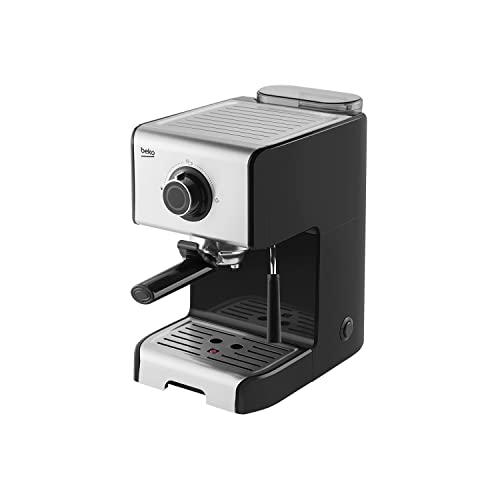How to Make Espresso Machine Coffee
An espresso machine can make a delicious cup of coffee, however it requires some extra set-up and upkeep than a traditional drip coffee maker. It is also necessary to grind and tamp the beans by yourself.
Pressure is the key to making espresso. The way espresso machines work is that the heating vessel heats the water to the right temperature, then forces it out of the spouts and through the grounds.

Temperature
Espresso is produced when hot water is forced under pressure through finely roasted coffee. The temperature of water is vital to the final shot. Temperatures that are too low can result in a absence of flavor compounds. The high temperatures can cause excessive extraction, which could cause bitter or burned taste.
The ideal temperature for espresso is between 195 and 205degF. This temperature can be achieved using a grouphead designed to maintain an unchanging temperature and stability throughout the process of brewing. The most sought-after type of group head is the E61 that provides a combination of temperature stability with pre-infusion and lever control.
When altering the espresso machine to accommodate different roasts and brew ratios it is crucial to take into consideration the impact of temperature on the extraction yield and crema. The ideal temperature will depend on the specific bean and roast however the general rule is that lighter roasts and higher brew ratios require higher temperatures than dark roasts and lower brew ratios. In addition, a good thermocouple is crucial for maintaining a consistent temperature.
Pressure
During the brewing procedure espresso machine coffee is pushed under pressure through finely ground coffee grounds that have been stamped. This causes chemical reactions to extract flavors, oils and other soluble ingredients. The drink that is produced is typically more flavorful and richer.
The ideal espresso machine's pressure is nine bar of pressure, which is equal to the atmospheric pressure at sea level. This is due to the fact that it's at this pressure the soluble compounds in espresso beans are most easily extracted.
However certain espresso machines advertise 15 or even 20 bars of pressure. While these machines may reach these pressure levels however, they might not be in a position to maintain that level of pressure throughout the extraction.
One bar of pressure equals to 32 pounds per square inch (PSI) of a car's tire. It's also four times the amount of pressure that professional cyclists use when pumping up their bicycle tires. Any serious home barista has to be able to regulate the pressure of their espresso machine and make consistent espressos.
Water
The water you use in your espresso machine is one of the most crucial elements of a great cup coffee. The right water helps your beans to extract their full potential. However the wrong type of water could cause issues such as clogged pipes and damage to your expensive machine.
The best choice is a natural spring water that is rich in minerals for optimal espresso extraction. This water will enhance the taste of your brew without the chalky mineral trace that comes from tap or bottled water. This is an excellent alternative to distilled or reverse osmosis filtered water, which can be too pure and cause issues with flavor.
You should not utilize a water filtration device that removes the mineral content of your tap water. This can result in flavor and extraction problems. Get a water test kit to determine the average hardness of your water at the local level. This can be used to determine a filtration system that will give you the correct water specs for your espresso machine.
Beans
The majority of coffee enthusiasts become enthralled in the entire process of making espresso. They are obsessed with a range of variables, including temperature, water pressure, beans, milk, viscosity, and other factors. If one of the variables is not in order, the entire shot could taste bad.
The beans used are the most important factor when it comes to espresso. It is often believed that only certain types of beans work well to be used in espresso. Although some beans are more suitable for certain uses however, any coffee bean that has been roasted can be used to make espresso. The main difference between espresso beans and regular coffee beans is that espresso beans are roasted longer, tipycally past the second crack which gives them a darker appearance and makes them more water-soluble.
The best espresso beans are typically medium roasted or dark roasted, giving the espresso shots their distinctive richness and vigor. However, it's possible to make excellent espresso using light roast beans, especially when these beans are ground (for convenience in an espresso machine).
Milk
Espresso and milk are a classic combination. The coffee doesn't just increase energy levels, but the steaming milk helps to offset the bitterness of espresso and adds a delicious creamy flavor. There aren't many culinary combinations more perfect than this one!
If you decide to purchase an espresso machine that can also create cappuccino or latte take a consider how easy it is to use. Many of the top espresso machines feature an ice cube that can be filled with cold or hot milk, a steam wand and an espresso portafilter to pull the shot. Some models have a built-in grinder, tamper, and frother.
The steam wand needs to be purged before making use of it for the first time in a day (or after every cup of espresso) to clear out any condensed water. The process takes only 30 seconds, yet it is vital to ensure that your machine stays running smoothly. If you don't flush the system, it could cause bitter taste and/or buildup of bacteria, which could alter the taste or odor of your beverage. It's easy to perform and should be part of your routine maintenance.
